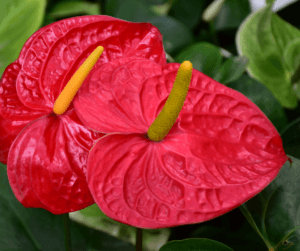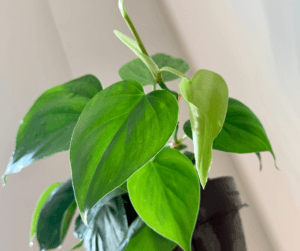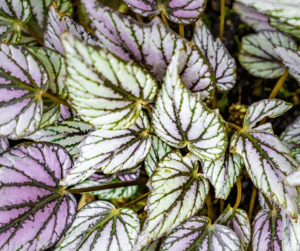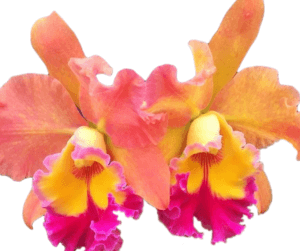The number of houseplant lovers has risen by leaps and bounds in recent years. If someone you care for is among them, consider giving a houseplant for Valentine’s Day. There are many that fit the holiday theme nicely. All are guaranteed to last longer than cut flowers and, unlike chocolate, will not automatically adhere to the recipient’s hips.
The plants below are some of the best choices for Valentine’s giving:
Heart on Your Leaves
Anthurium (Anthurium sp.), sometimes known as “flamingo plant” or “flamingo lily” is native to Central and South American and is only hardy in USDA plant hardiness Zones 11 and 12. Fortunately, it will get along quite nicely in average living spaces. What makes anthurium perfect for V Day are the long-lasting “flowers” which are really red (or sometimes pink or white) heart-shaped spathes, surrounding smaller true flowers and a central staminal column. The large, glossy green leaves are also heart-shaped and are attractive even after the flowers have faded.
Anthuriums like drainage, so when potting or repotting, add a layer of gravel to the bottom of the container, and fill with a quality potting compound like Fafard Natural and Organic Potting Mix. Position the container in a spot with bright light and make sure the plant receives consistent moisture. The plants can vacation outside in a lightly shaded spot when night temperatures are reliably above 50 degrees Fahrenheit.

Heart Leaf Philodendron (Philodendron scandens, sometimes known as Philodendron hederaceum) is just what the name suggests—a houseplant with heart-shaped leaves. With its long, vining stems, philodendron is a natural for hanging baskets or containers positioned on pedestals. Like anthuriums, philodendrons are Central and South American natives that cannot survive outdoors in cold winter climates. The plants grow in dappled shade in their native areas, so available light in most homes suits them just fine. Watering is easy—just wait until the surface of the soil feels dry and then water thoroughly. Feed with houseplant fertilizer according to manufacturer’s directions.
For a more adventurous Valentine’s Day gift, seek out a variegated variety, like ‘Silver Stripe’, with a lighter green stripe down the middle of each leaf, or ‘Lemon Lime’, with bright chartreuse foliage.
Philodendrons have only one downside—ingestion of any part of the plant is toxic to humans and animals, so position the plant so it is inaccessible to household inhabitants who might be likely to sample the leaves.

Take a fancy to these leaves
Rex Begonias: Whether you call them “rex begonias” or “painted leaf begonias”, these hybrid beauties, officially known as Begonia rex, are easy to grow and even easier on the eyes. They make excellent Valentine’s day gifts. Unlike other begonia species, Rexes are grown primarily for their gorgeous foliage. Some of the leaves are heart-shaped, while others are intricately lobed or swirled like snail shells. “Painted leaf” is a perfect descriptor–the leaves are often bi- or tri-colored, streaked, swirled or edged in shades of green, silver, red, purple, or maroon, often with contrasting veins.
Growing only 12 to 14 inches tall, Rexes like a sunny windowsill. Water only when the soil surface is dry (watering around the edges of the pot helps prevent root rot). Standing the container atop a layer of pebbles in a water-filled tray ensures that the plants get the humidity they enjoy. Growth slows down a bit in the winter, but that should not cause discouragement.
Available varieties abound, with flashy specimens like ‘China Curl’, with a broad silver swirl accenting each leaf’s center and edging of darkest maroon; and ‘Paso Doble’, with spiraling leaves of rose and bright green. Begonia leaves are also harmful to children and pets.

The wonder of Orchids
Orchids have long been considered among the most romantic plants. Tissue culture, which allows growers to propagate large numbers of plants from small tissue samples, has made these exotic-looking bloomers—at least some of them–attainable for non-millionaires. Probably the easiest to grow and the most reasonably priced is the moth orchid (Phalaenopsis), with its pristine blossoms. White is the most common color, but hybridizers have been busy producing “moths” in red, yellow, peach, cream and related shades. Some sport attractive “freckles” as well. Buy the orchids either in flower or budded. Blooms will sometimes last up to three months.
Breeders work constantly to produce new hybrids, and the so-called “Rlc” orchids (Rhyncholaeliocattleya hybrids) are the happy and colorful result of crosses involving at least three species. More costly than moth orchids, the Rlc’s boast ease of care, vibrant colors and even fragrance. With large, frilly flowers, they are living corsages that will remain in flower for up to three weeks and may bloom more than once a year.
Orchids have sometimes been portrayed as fussy plants that need lots of coddling. Some species might, but all the moth and Rlc orchids really want is the indirect light of an east or west-facing window, and the humid environment provided by a room humidifier or a tray filled with pebbles and water. A porous growing medium is a good idea, as is an unglazed clay or terra cotta pot. If the plant arrives crammed into a plastic pot filled with ordinary potting soil, wait until the flowers fade and repot appropriately. Water only when the soil is quite dry. When in doubt, check the exposed roots. Plump roots indicate the orchid’s water needs have been met. When the plant is in active growth (forming new leaves and flower buds), feed with an orchid-specific fertilizer according to manufacturer’s directions.


